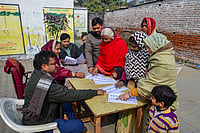On May 3, a 'Tribal Solidarity March' was organised in the hill districts of Manipur to protest against the Meitei community's demand for Scheduled Tribe (ST) status. Sporadic incidents of violence had erupted in the months before that, too, but what happened next was unprecedented.
It has been six months since the northeastern state of Manipur went into turmoil. Flames rose to the skies as houses were burnt, vehicles and public properties were vandalised, women were brutalised, protesters were charged with batons while rebels engaged in gunfights using arms and ammunition stolen from cops. More than 180 people have been killed in the ongoing violence. There has been no calm in Manipur since May, even as some days the situation improved.
The unrest drew international attention for the first time in July, on grounds of human rights violation when a horrific video of two Kuki women being paraded naked by a mob after they were tortured and raped went viral on social media. The BJP-led Union government, however, has been eerily silent on the issue, showing negligible urgency for a solution.
The situation turned further grim when, in September, the Manipur government extended the controversial AFSPA to all areas of the state, barring those that come under the purview of 19 police stations, mostly located in the Imphal Valley or other Meitei-dominated areas. The 'disturbed areas' status came into effect in restive Manipur from October 1.
The violence has also had its impact on the upcoming state Assembly elections. During the campaign in poll-bound Mizoram, Defence Minister Rajnath Singh distanced the BJP from the Manipur violence, saying it had "not been done by any political party". "In the last nine years, the Northeast has been very peaceful," he said.
But Manipur’s ethnic clashes have a history much longer than six months. What historically used to be a conflict between the Naga and Kuki tribes has turned into clashes between the Meiteis, who dominate the Imphal Valley and constitute 53 per cent of the state’s population, and Kuki-Zo hill tribes, who inhabit the hill areas.
Earlier this week, things turned violent again in Imphal, the capital city, as security forces fired several rounds in the air to disperse a crowd of over 2,000 individuals who had attempted to loot an armoury within the premises of the 1 Manipur Rifles camp, located in close proximity to the Raj Bhavan and the Chief Minister's Office, situated in the Imphal West district.
Markets remained shut as a curfew relaxation notice by the district administration was withdrawn. Additional state and central forces were deployed at major junctions and police personnel were seen patrolling the area near the Manipur Rifles camp.
The relaxation was announced again on Thursday with the condition that it "does not apply to any gathering or large-scale movement of persons or sit in protests or rally". The latest tensions were sparked by the death of an SDPO —an officer of the rank of deputy superintendent of police belonging to the majority community— who was shot by tribal militants at Moreh town.
With no solution in sight, the physical and mental boundaries between the two communities continue to grow amid the looming paranoia and fear etched on the faces of the residents. In this light, Outlook takes a deeper look at the last six months of Manipur crisis and the years of history that led to it.


























